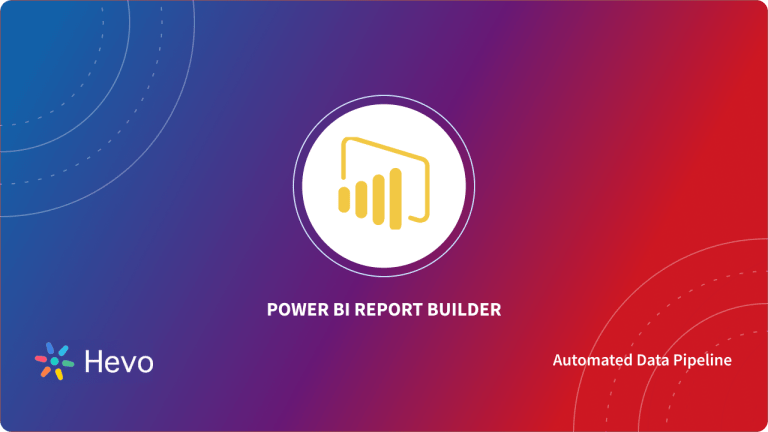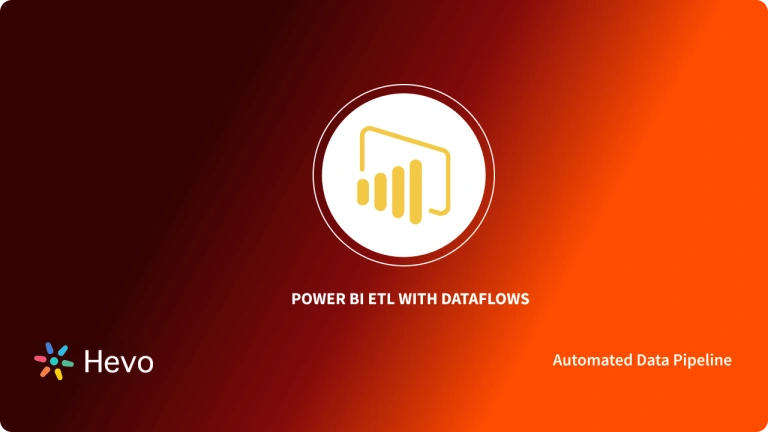Importance of Transform Data Power BI along with a brief introduction to the salient features of Power BI before delving into Power BI Transform Data methods.
- Power BI is a Business Intelligence (BI) tool offered by Microsoft that provides you with real-time high-level analytics, extensive modeling, and custom development.
- It has led the charge in making business analysis more efficient through services that are intuitive, interactive, and easy to use.
Table of Contents
What is Power BI?

Power BI is a Microsoft business Intelligence product that allows users to analyze data from many sources and build Reports and Dashboards. Power BI allows one to connect to various data sources for the transformation of raw data and create interactive reports and dashboards for data analysis and decision-making. Power BI is very popular because it can present data in visually appealing forms and deliver real-time insights.
Looking for the best ETL tools to connect your Snowflake account? Rest assured, Hevo’s no-code platform seamlessly integrates with Snowflake streamlining your ETL process. Try Hevo and equip your team to:
- Integrate data from 150+ sources(60+ free sources).
- Simplify data mapping with an intuitive, user-friendly interface.
- Instantly load and sync your transformed data into Snowflake.
Choose Hevo and see why Deliverr says- “The combination of Hevo and Snowflake has worked best for us. ”
Get Started with Hevo for FreeFeatures of Power BI
- Power BI can connect to a wide range of data sources, including databases (SQL, Oracle), cloud services (Azure, Salesforce), Excel, and web services.
- Supports both cloud-based (Power BI Service) and on-premises (Power BI Desktop) data sources.
- Power Query allows users to clean, transform, and load data. It offers data cleansing tools such as merging, filtering, grouping, and reshaping data.
- Power BI offers DAX, a powerful formula language for creating custom calculations and measures in reports.
- Power BI integrates with Azure AI and Cognitive Services, allowing users to perform natural language queries, sentiment analysis, and predictive analytics.
What is Power BI Power Query Editor?
- Power BI Power Query Editor can be used to edit or transform data files before they get loaded into the Power BI dashboard.
- The Query Editor serves as an intermediate data container that allows you to modify data by choosing columns and rows, pivoting and unpivoting columns, splitting columns and rows, etc.
Why do you need to Transform Data in Power BI?
- Data Cleaning: Real-world data often contains errors, inconsistencies, duplicates, or missing values. Transforming data helps clean and standardize it, ensuring accurate reporting and analysis.
- Data Integration: Power BI pulls data from multiple sources like databases, files, or web services. Transformation allows you to merge, join, or append this data into a unified dataset for analysis.
- Data Shaping: Raw data might not be in the right format or structure for analysis. Transforming data (e.g., pivoting, unpivoting, or splitting columns) reshapes it into a format that’s easier to work with for creating visuals.
- Performance Optimization: Complex datasets can slow down Power BI reports. By transforming data, you can reduce unnecessary columns or rows, filter data, or aggregate it, improving performance.
Steps to Transform Power BI Data
- Step 1: You can go to the “Home” tab in the ribbon section and click on “Get Data” to provide you with the options to source the data from a different platform.
- Step 2: Since you have your unsorted data in Excel, choose “Excel” from the menu.
- Step 3: This will open up a window to choose the “Excel file” that you wish to upload from your device.
- Next, the Navigator page prompts you to select the datasheets that you wish to work with. You can accordingly check to mark the sheets you want to. Since the primary aim was to sort the data, you can go with the “Transform Data” option.
- You can click on Load to upload the file without any transformation.
- Step 4: Power BI Transform Data button would then take you to another window, also known as the Power BI Power Query Editor, where you will be transforming and cleaning your data.
Types of Transformations to Perform Using Power BI
How to Perform Renaming Operations in Power BI?
1. Renaming Data Sources in Power BI
- If you take a look at the left corner of the Power BI Query Editor window, you can see an option dubbed “Queries”.
- Under this Power BI Transform Data session, all the different data sources are listed with the default data source’s file name, i.e., when an SQL table is loaded, the table’s name gets listed in this session, and if you load an Excel file, then it’s file name shows up.
2. Renaming Tables in Power BI
- If you are not satisfied with the name given to the Power BI Transform Data tables.
- You can change the name by implementing one of the two Power BI Transform Data options mentioned in the figure below.
- You just need to double-click the name you wish to change and specify the new name:
3. Renaming Power BI Columns
- The simplest task in Power BI transform data is to rename the column heading.
- Just “Double-Click” on the column heading highlighted with a blue mark, and you can replace its name with a new header.
4. Renaming Queries in Power BI
- You can rename the Power BI Transform Data query in the Query Settings pane on the right-hand side of the canvas.
- The Power BI Transform Data Query Settings pane also houses the ‘Applied Steps’ list. Therefore, every change you make to your data generates a new step on the list making it easier to undo any unwanted changes.
How to Perform Removal Operations in Power BI?
1. Removing Columns & Rows in Power BI
- When working on a larger dataset, you do not need all the data. You can refine the data by removing unwanted columns and rows.
- To execute this Power BI Transform Data step in the Power BI Query Editor, you need to navigate to Choose Columns, Remove Columns, Keep Rows, and Remove Rows options as mentioned under the Home tab.
- By leveraging these Power BI Transform Data options, you can easily look to remove some of the unwanted data.
2. Removing Records with Power BI Data Filters
- You can also easily remove specific rows that aren’t needed in your dataset by leveraging a Power BI Transform Data filter.
- The menu can help remove columns that are empty, that end or start with a specific value. Similar to the steps required to clean the dataset, this Power BI Transform Data step makes it easier to navigate for your end-user and helps them answer their questions quicker.
3. Removing Duplicates from Power BI Datasets
- Removing duplicates comes in handy when you have to load in an unfamiliar dataset that hasn’t come from a trusted data source especially if the dataset is quite large.
- This Power BI Transform Data step can be done in Excel but this gets more difficult with larger datasets.
- This can also be done in a database but if you don’t have permission to load the data, this Power BI Transform Data might not be a good option for you.
How to Perform Merge Operations in Power BI?
1. Merging Columns in Power BI
- Step 1: Choose the two columns you wish to merge and go to “Add Column”.
- Step 2: Next, choose the “Merge Columns” option.
- Step 3: The previous step prompts the Merge Columns page where you can specify the specific separator for the columns and click on “OK” to finish this Power BI transform data step.
2. Using the Pivots in Power BI
- Step 1: Select the column you wish to pivot.
- Step 2: On the Transform tab in the Any column group, choose the Pivot column.
- Step 3: Next, in the pivot dialog box, in the Value column list, you can choose Value.
- Step 4: By default, Power Query will try to execute a sum as the aggregation, but you can choose the Advanced option to sift through the other available aggregations before deciding on the one you like.
3. Unpivoting Data in Power BI
Therefore, you might want to separate it into two columns where one column shows you the Sale made and another column depicts the Region.
- Step 1: Choose all four columns, right-click on any heading, and then choose “Unpivot Columns”. This will result in two new columns, called Value and Attribute as shown below. You can rename these two columns by following the steps mentioned in the Renaming Columns section.
How to Change/Modify Data Types in Power BI?
- Step 1: Select the column and “Right Click” on the column header.
- Step 2: This prompts a drop-down list from which you can select “Change Type”.
- Step 3: When you select it, a drop-down list appears with a list of different data types to choose from. You can choose the data type you like, say Fixed Decimal Number. Here are the results for the same:
How to Format Text & Replace Values in Power BI?
- You can find the replace values option on the ‘Transform’ tab of the ribbon.
- The advanced menu provides you with the option to insert special characters to match the entire cell contents.
- This might come in handy since datasets may be loaded with typos that need cleaning up or values that aren’t as detailed as expected.
- You can find formatting options in the ‘Transform’ tab of the ribbon that can be used to clean, trim, and change the case of the text.
- This can come in handy because cleansing text fields make it easier to execute and read further transformations. The ‘Trim’ option is especially handy when you want to remove any trailing or leading spaces.
Additional Resources
- Explore more on Data Transformation
- Read more about Snowflake Data Transformation
- Explore more on Data Transformation Tools
Conclusion
- This blog talks about the different methods you can use to implement Power BI Transform Data seamlessly.
- It also gives the salient features of Power BI, Power BI Query Editor, and the importance of Power BI Transform Data for efficient data operations for your business use case.
Want to take Hevo for a spin? Sign Up for a 14-day free trial and experience the feature-rich Hevo suite first hand. You can also have a look at our unbeatable pricing that will help you choose the right plan for your business needs!
FAQs
1. What is transformation in BI?
The process of cleaning, structuring, and converting raw data into a format suitable for analysis.
2. Can I do ETL in Power BI?
Power BI provides ETL-like capabilities through Power Query Editor for data extraction, transformation, and loading, though it is not a full-featured ETL tool.
3. What are dax formulas?
A formula language used in Power BI to create custom calculations, aggregated measures, and perform complex data analysis.












